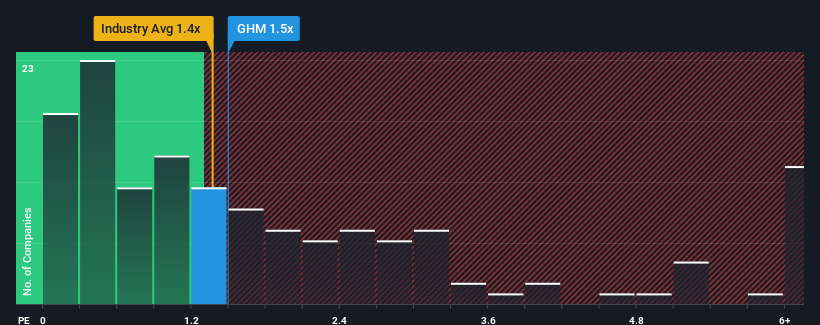- United States
- /
- Machinery
- /
- NYSE:GHM
Investors Still Aren't Entirely Convinced By Graham Corporation's (NYSE:GHM) Revenues Despite 27% Price Jump
Despite an already strong run, Graham Corporation (NYSE:GHM) shares have been powering on, with a gain of 27% in the last thirty days. Looking back a bit further, it's encouraging to see the stock is up 90% in the last year.
In spite of the firm bounce in price, there still wouldn't be many who think Graham's price-to-sales (or "P/S") ratio of 1.5x is worth a mention when the median P/S in the United States' Machinery industry is similar at about 1.4x. However, investors might be overlooking a clear opportunity or potential setback if there is no rational basis for the P/S.
View our latest analysis for Graham

What Does Graham's P/S Mean For Shareholders?
With revenue growth that's superior to most other companies of late, Graham has been doing relatively well. It might be that many expect the strong revenue performance to wane, which has kept the P/S ratio from rising. If you like the company, you'd be hoping this isn't the case so that you could potentially pick up some stock while it's not quite in favour.
If you'd like to see what analysts are forecasting going forward, you should check out our free report on Graham.How Is Graham's Revenue Growth Trending?
In order to justify its P/S ratio, Graham would need to produce growth that's similar to the industry.
If we review the last year of revenue growth, the company posted a terrific increase of 17%. The latest three year period has also seen an excellent 89% overall rise in revenue, aided by its short-term performance. Therefore, it's fair to say the revenue growth recently has been superb for the company.
Shifting to the future, estimates from the dual analysts covering the company suggest revenue should grow by 6.2% over the next year. That's shaping up to be materially higher than the 1.7% growth forecast for the broader industry.
With this in consideration, we find it intriguing that Graham's P/S is closely matching its industry peers. It may be that most investors aren't convinced the company can achieve future growth expectations.
What We Can Learn From Graham's P/S?
Its shares have lifted substantially and now Graham's P/S is back within range of the industry median. Typically, we'd caution against reading too much into price-to-sales ratios when settling on investment decisions, though it can reveal plenty about what other market participants think about the company.
Despite enticing revenue growth figures that outpace the industry, Graham's P/S isn't quite what we'd expect. When we see a strong revenue outlook, with growth outpacing the industry, we can only assume potential uncertainty around these figures are what might be placing slight pressure on the P/S ratio. However, if you agree with the analysts' forecasts, you may be able to pick up the stock at an attractive price.
It's always necessary to consider the ever-present spectre of investment risk. We've identified 1 warning sign with Graham, and understanding should be part of your investment process.
It's important to make sure you look for a great company, not just the first idea you come across. So if growing profitability aligns with your idea of a great company, take a peek at this free list of interesting companies with strong recent earnings growth (and a low P/E).
New: Manage All Your Stock Portfolios in One Place
We've created the ultimate portfolio companion for stock investors, and it's free.
• Connect an unlimited number of Portfolios and see your total in one currency
• Be alerted to new Warning Signs or Risks via email or mobile
• Track the Fair Value of your stocks
Have feedback on this article? Concerned about the content? Get in touch with us directly. Alternatively, email editorial-team (at) simplywallst.com.
This article by Simply Wall St is general in nature. We provide commentary based on historical data and analyst forecasts only using an unbiased methodology and our articles are not intended to be financial advice. It does not constitute a recommendation to buy or sell any stock, and does not take account of your objectives, or your financial situation. We aim to bring you long-term focused analysis driven by fundamental data. Note that our analysis may not factor in the latest price-sensitive company announcements or qualitative material. Simply Wall St has no position in any stocks mentioned.
About NYSE:GHM
Graham
Designs and manufactures fluid, power, heat transfer, and vacuum technologies for chemical and petrochemical processing, defense, space, petroleum refining, cryogenic, and energy industries.
Flawless balance sheet with proven track record.
Similar Companies
Market Insights
Community Narratives





